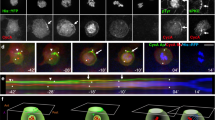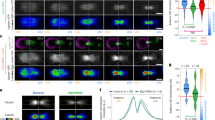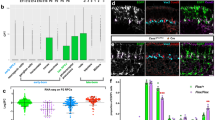Abstract
Cell-fate diversity is generated in part by the unequal segregation of cell-fate determinants during asymmetric cell divisions. In the Drosophila pupa, the pI sense organ precursor cell is polarized along the anterior–posterior axis of the fly and divides asymmetrically to generate a posterior pIIa cell and an anterior pIIb cell. The anterior pIIb cell specifically inherits the determinant Numb and the adaptor protein Partner of Numb (Pon). By labelling both the Pon crescent and the microtubules in living pupae, we show that determinants localize at the anterior cortex before mitotic-spindle formation, and that the spindle forms with random orientation and rotates to line up with the Pon crescent. By imaging living frizzled (fz) mutant pupae we show that Fz regulates the orientation of the polarity axis of pI, the initiation of spindle rotation and the unequal partitioning of determinants. We conclude that Fz participates in establishing the polarity of pI.
This is a preview of subscription content, access via your institution
Access options
Subscribe to this journal
Receive 12 print issues and online access
$209.00 per year
only $17.42 per issue
Buy this article
- Purchase on Springer Link
- Instant access to full article PDF
Prices may be subject to local taxes which are calculated during checkout







Similar content being viewed by others
References
Jan, Y. N. & Jan, L. Y. Polarity in cell division: what frames thy fearful asymmetry? Cell 100, 599– 602 (2000).
Lu, B., Rothenberg, M., Jan, L. Y. & Jan, Y. N. Partner of Numb colocalizes with Numb during mitosis and directs Numb asymmetric localization in Drosophila neural and muscle progenitors. Cell 95, 225–235 ( 1998).
Lu, B., Ackerman, L., Jan, L. Y. & Jan, Y.-N. Modes of protein movement that lead to the asymmetric localization of Partner of Numb during Drosophila neuroblast division. Mol. Cell 4, 883–891 (1999).
Knoblich, J. A., Jan, L. Y. & Jan, Y. N. The N terminus of the Drosophila Numb protein directs membrane association and actin-dependent asymmetric localization. Proc. Natl Acad. Sci. USA 94, 13005– 13010 (1997).
Kaltschmidt, J. A., Davidson, C. M., Brown, N. H. & Brand, A. H. Rotation and asymmetry of the mitotic spindle direct asymmetric cell division in the developing central nervous system Nature Cell Biol. 2, 7–12 (2000).
Kraut, R., Chia, W., Jan, L. Y., Jan, Y. N. & Knoblich, J. A. Role of inscuteable in orienting asymmetric cell divisions in Drosophila. Nature 383, 50–55 (1996).
Wodarz, A., Ramrath, A., Kuchinke, U. & Knust, E. Bazooka provides an apical cue for Inscuteable localization in Drosophila neuroblasts. Nature 402, 544– 547 (1999).
Schober, M., Schaefer, M. & Knoblich, J. A. Bazooka recruits Inscuteable to orient asymmetric cell divisions in Drosophila neuroblasts. Nature 402, 548–551 (1999).
Hyman, A. A. Centrosome movement in the early divisions of Caenorhabditis elegans: a cortical site determining centrosome position. J. Cell Biol. 109, 1185–1193 (1989).
Skop, A. R. & White, J. G. The dynactin complex is required for cleavage plane specification in early Caenorhabditis elegans embryos. Curr. Biol. 8, 1110–1116 (1998).
Sawa, H., Lobel, L. & Horvitz, H. R. The Caenorhabditis elegans gene lin-17, which is required for certain asymmetric cell divisions, encodes a putative seven-transmembrane protein similar to the Drosophila frizzled protein. Genes Dev. 10, 2189–2197 ( 1996).
Thorpe, C. J., Schlesinger, A., Carter, J. C. & Bowerman, B. Wnt signaling polarizes an early C. elegans blastomere to distinguish endoderm from mesoderm Cell 90, 695– 705 (1997).
Rocheleau, C. E. et al. Wnt signaling and an APC-related gene specify endoderm in early C. elegans embryos. Cell 90, 707–716 (1997).
Schlesinger, A., Shelton, C. A., Maloof, J. N., Meneghini, M. & Bowerman, B. Wnt pathway components orient a mitotic spindle in the early Caenorhabditis elegans embryo without requiring gene transcription in the responding cell. Genes Dev. 13, 2028–2038 (1999).
Gho, M. & Schweisguth, F. Frizzled signalling controls orientation of asymmetric sense organ precursor cell divisions in Drosophila . Nature 393, 178–181 (1998).
Gho, M., Bellaiche, Y. & Schweisguth, F. Revisiting the Drosophila microchaete lineage: a novel intrinsically asymmetric cell division generates a glial cell. Development 126, 3573–3584 (1999).
Rhyu, M. S., Jan, L. Y. & Jan, Y. N. Asymmetric distribution of numb protein during division of the sensory organ precursor cell confers distinct fates to daughter cells Cell 76, 477–491 (1994).
Brand, A. H. & Perrimon, N. Targeted gene expression as a means of altering cell fates and generating dominant phenotypes. Development 118, 401–415 ( 1993).
Keating, H. H. & White, J. G. Centrosome dynamics in early embryos of Caenorhabditis elegans. J. Cell Sci. 111, 3027–3033 (1998).
Adler, P. N., Charlton, J. & Vinson, C. Allelic variations at the frizzled locus of Drosophila . Dev. Genet. 8, 99– 119 (1987).
Lee, L. et al. Positioning of the mitotic spindle by a cortical-microtubule capture mechanism. Science 287, 2260– 2262 (2000).
Korinek, W. S., Copeland, M. J., Chaudhuri, A. & Chant, J. Molecular linkage underlying microtubule orientation toward cortical sites in yeast. Science 287, 2257– 2259 (2000).
Lu, B., Usui, T., Uemura, T., Jan, L. & Jan, Y. N. Flamingo controls the planar polarity of sensory bristles and asymmetric division of sensory organ precursors in Drosophila. Curr. Biol. 9, 1247–1250 (1999).
Heitzler, P. & Simpson, P. The choice of cell fate in the epidermis of Drosophila. Cell 64, 1083– 1092 (1991).
Buescher, M. et al. Binary sibling neuronal cell fate decisions in the Drosophila embryonic central nervous system are nonstochastic and require inscuteable-mediated asymmetry of ganglion mother cells. Genes Dev. 12, 1858–1870 (1998).
Nern, A. & Arkowitz, R. A. A Cdc24p-Far1p-Gbetagamma protein complex required for yeast orientation during mating. J. Cell Biol. 144, 1187–1202 ( 1999).
Usui, K. & Kimura, K.-i. Sequential emergence of the evenly spaced microchaetes on the notum of Drosophila. Roux's Arch. Dev. Biol. 203, 151–158 (1993).
Kanda, T., Sullivan, K. F. & Wahl, G. M. Histone–GFP fusion protein enables sensitive analysis of chromosome dynamics in living mammalian cells. Curr. Biol. 8, 377–385 ( 1998).
Haseloff, J., Dormand, E.-L. & Brand, A. H. in Protocols in Confocal Microscopy (Humana Press, 1999).
Verkhusha, V. V., Tsukita, S. & Oda, H. Actin dynamics in lamellipodia of migrating border cells in the Drosophila ovary revealed by a GFP–actin fusion protein . FEBS Lett. 445, 395–401 (1999).
Gho, M., Lecourtois, M., Geraud, G., Posakony, J. W. & Schweisguth, F. Subcellular localization of Suppressor of Hairless in Drosophila sense organ cells during Notch signalling. Development 122, 1673– 1682 (1996).
Acknowledgements
We thank P. Adler, W. Chia, Y.-N. Jan, T. Kanda, B.-W. Lu, N. Perrimon, J.-R. Martin, A. Martinez-Arias, E. Spana, G. M. Wahl and the Developmental Studies Hybridoma Bank for antibodies, plasmids and flies. We also thank G. Géraud and the confocal imaging facility of the Institut Jacques Monod, as well as the Electron Microscopy Facility of the University Paris 6 for use of confocal and SEM microsocopes. We thank A. Martinez-Arias, P. van Roessel and R. LeBorgne for critical reading. This work was supported in part by grants from the Centre National de la Recherche Scientifique (ATIPE), the Association pour la Recherche contre le Cancer (ARC 5951) and by the Wellcome Trust.
Author information
Authors and Affiliations
Corresponding author
Supplementary information
Movie 1
pI divides unequally with a stereotyped planar orientation Wide-field time-lapse imaging of two dividing microchaete pI cells located in row 1. These pI cells, which specifically express gap-GFP under the control of neuP72, divide with a fixed orientation relative to the a-p axis, each generating a small anterior pIIb cell and a large posterior cell. Anterior is up. (MOV 50 kb)
Movie 2
Pon-GFP accumulates at the anterior cortex during prophase Wide-field time-lapse imaging of a pI cell expressing both Histone2B-YFP and Pon-GFP. Progression into mitosis was followed using H2B-YFP to reveal chromatin condensation, alignment of the chromosomes onto the metaphase plate, chromosome migration to the pole and re-formation of daughter nuclei. Pon-GFP localises to the anterior cortex at late prophase. The perinuclear accumulation of Pon-GFP is masked by H2B-YFP. Anterior is up. (MOV 865 kb)
Movie 3
Centrosome movement and spindle dynamics in pI cells (1) Wide-field time-lapse imaging of pI cells expressing tau-GFP under the control of neuP72, showing centrosome separation and migration, mitotic spindle formation at prometaphase followed by a 45° rotation. In this movie, the centrosome that is eventually inherited by the posterior pIIb cell is closely associated with the nucleus and starts migrating around the nucleus before the other centrosome. The initial position of the centrosome relative to the nucleus does not, however, correlate with a specific spindle pole. Also, centrosome rotation starts prior to spindle formation. Anterior is up. (MOV 341 kb)
Movie 4
Centrosome movement and spindle dynamics in pI cells (2) Wide-field time-lapse imaging of pI cells expressing tau-GFP under the control of neuP72, showing a nearly 90° spindle rotation. Anterior is up. (MOV 311 kb)
Movie 5
Spindle rotation directs the unequal segregation of Pon-GFP (1) Wide-field time-lapse imaging of a pI cell expressing both Pon-GFP and tau-GFP under the control of neuP72, showing formation of the Pon-GFP crescent prior to spindle formation and spindle rotation relative to the crescent of Pon-GFP. Anterior is up. (MOV 391 kb)
Movie 6
Spindle rotation directs the unequal segregation of Pon-GFP (2) Wide-field time-lapse imaging of a pI cell expressing both Pon-GFP and tau-GFP under the control of neuP72, showing that the spindle rotates by 90¡ to line up with the anterior crescent of Pon-GFP. Anterior is up. (MOV 322 kb)
Movie 7
Spindle rotation and orientation in frizzled mutant pI cells (1) Wide-field time-lapse imaging of a fzK21/fzKd4a mutant pI cell that expresses tau-GFP under the control of neuP72, showing bidirectional spindle rotation during metaphase. pI divides with an abnormal orientation relative to the a-p axis, and generates a small pIIb cell toward the posterior pole (bottom-right corner). Anterior is up. (MOV 149 kb)
Movie 8
Spindle rotation and orientation in frizzled mutant pI cells (2) Confocal time-lapse imaging of a fzK21/fzKd4a mutant pI cell that expresses tau-GFP under the control of neuP72. Anterior is up. (MOV 29 kb)
Movie 9
Pon-GFP accumulates at the anterior cortex during prophase Confocal time-lapse imaging of a control neuP72 fzKd4a UAS-Pon-GFP / + pI cell expressing Pon-GFP under the control of neuP72. Pon-GFP is intially found around the nucleus and in basal cytoplasmic extensions that retract during prophase. Pon-GFP accumulates at the anterior pole during prophase, and segregates into the anterior pIIb cell. Anterior is up. (MOV 32 kb)
Movie 10
Unequal segregation of Pon-GFP in frizzled mutant pI cells (1) Confocal time-lapse imaging of a fzK21 / neuP72 fzKd4a UAS-Pon-GFP mutant pI cells. Pon-GFP forms a randomly positioned crescent in fz mutant pI cells. In this movie, Pon-GFP localises in an abnormally large lateral crescent, and cytokinesis bisects this Pon-GFP crescent, thereby leading to the segregation of Pon-GFP to both daughter cells. Anterior is up. (MOV 566 kb)
Movie 11
Unequal segregation of Pon-GFP in frizzled mutant pI cells (2) Wide-field time-lapse imaging of a fzK21 / neuP72 fzKd4a UAS-Pon-GFP mutant pI cells. Pon-GFP forms a randomly positioned crescent in fz mutant pI cells. In this movie, Pon-GFP localises in an abnormally large posterior crescent and cytokinesis bisects this Pon-GFP crescent, thereby leading to the segregation of Pon-GFP to both daughter cells. Anterior is up. (MOV 1106 kb)
Movie 12
Unequal segregation of Pon-GFP in frizzled mutant pI cells (3) Wide-field time-lapse imaging of a fzK21 UAS-tau-GFP / neuP72 fzKd4a UAS-Pon-GFP mutant pI cells. Pon-GFP localises asymmetrically prior to spindle formation and forms a large posterior crescent. In this pI cell, the spindle does not rotate significantly, and does not line up with the center of the Pon-GFP crescent, thereby leading to the partial mis-partitionning of Pon-GFP to both daughter cells. Anterior is up. (MOV 230 kb)
Rights and permissions
About this article
Cite this article
Bellaïche, Y., Gho, M., Kaltschmidt, J. et al. Frizzled regulates localization of cell-fate determinants and mitotic spindle rotation during asymmetric cell division. Nat Cell Biol 3, 50–57 (2001). https://doi.org/10.1038/35050558
Received:
Revised:
Accepted:
Published:
Issue Date:
DOI: https://doi.org/10.1038/35050558
This article is cited by
-
Polarized branched Actin modulates cortical mechanics to produce unequal-size daughters during asymmetric division
Nature Cell Biology (2023)
-
Co-option of epidermal cells enables touch sensing
Nature Cell Biology (2023)
-
Elongator stabilizes microtubules to control central spindle asymmetry and polarized trafficking of cell fate determinants
Nature Cell Biology (2022)
-
Cortical Cyclin A controls spindle orientation during asymmetric cell divisions in Drosophila
Nature Communications (2022)
-
Myosin efflux promotes cell elongation to coordinate chromosome segregation with cell cleavage
Nature Communications (2017)



